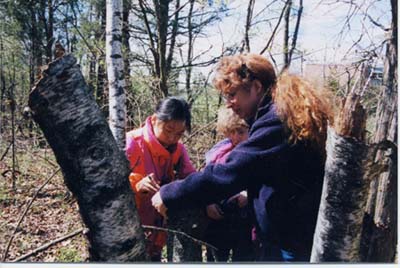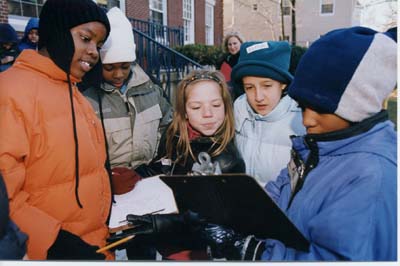( BACK TO POSTER )
Original goals for project sustainability under ideal conditions
"Starting from ground zero...." is where we were in 1995. Ground zero means that the partner districts had almost no science being taught in the k-3 classrooms, very little in the 4-6 level, and some very didactic science teaching in the 7-8 level. The original goals of our LSC team were set by staff at Montclair State University as well as in the partner districts. The goals were to:
- help teachers of two urban, mostly minority school districts reach a level of competency in science education such that they could effectively teach inquiry-based science to their K-8 students,
- cultivate a large cadre of enhanced teachers competent to teach inquiry-based approaches to other teachers,
- establish a long-term commitment by the partner districts to continuing education of their teaching work force through frequent high-quality inservice in science.
We had this grand vision of teachers with inquiry-centered classrooms and principals supporting science programs, and teachers teaching other teachers, and superintendents helping because the results made them look so good. ...
( BACK TO POSTER | BACK TO TOP )
Reflections on these goals from the end of the project funding cycle
Reality: A standardized state test that encourages inquiry-oriented instruction....How can this be?
- Since 1995, the State of New Jersey has instituted 3 important policy changes that have pushed the cause of our LSC in a desirable direction. This pushing was largely due to the efforts of the NJSSI team under Gerald Goldin, working closely with the NJ State Dept. of Education. The NJDOE has established State Core Content Standards in all disciplines, including science. The Standards document is accompanied by a Frameworks in Science document that lays out examples of investigatory classroom practices. Although the documents have faults, they have at least established the importance of science in the curricula of the 600 school districts in NJ. More recently, the DOE has also mandated that all teachers must complete at least 100 hours of professional development every 5 years for re-certification. This plan has its own faults, but does at least awaken the districts to the importance of on-going professional development. Lastly, the DOE established statewide testing at 4th and 8th grade levels, with results that surprised some....
- Rather than "dumbing down" teaching, Rutgers researchers suggest that the NJ 4th-grade test is "sensitizing teachers to new instructional practices even if it is not leading to major change." The study found that the New Jersey Elementary School Performance Assessment had encouraged teachers to try out more inquiry-oriented instruction in their classrooms. Such instruction included placing a greater emphasis on problem-solving, having students explain their thought processes, assigning students more writing, and making greater use of hands-on materials. The testing was begun in 1999, in the 4th year of our LSC project. The test is given statewide at the 4th-grade level and includes a mix of multiple-choice and short-answer items. William A. Firestone and colleagues at Rutgers University presented their findings at the annual meeting of the American Educational Research Association. The study included more than 300 4th grade teachers in New Jersey and surveyed the effects of that state's testing program on mathematics and science instruction. Story online at:
http://www.edweek.org/ew/ewstory.cfm?slug=31ASSESS.h20
- At the grassroots level, the LSC team developed enthusiasm among teachers for science teaching by teaching teachers for deep understanding using constructivist approaches. Then by empowering them to establish school study teams that could plan to improve the science learning environments in their schools, they could see visible changes that they owned. Through this "Focus Schools in Science" approach, we gained grassroots support for the LSC. We secured private local foundation grants to pay school study teams to plan and implement science enrichment programs. Activities included extended school-day science programs, evening family science events, Saturday science trips, and summer science camps. Teachers were paid from the private funds and the materials and refreshments were also provided, along with coaching and advice from our LSC office at the University. Teachers were encouraged to seek publicity through local newspapers and cable TV. The positive PR helped keep the principals on board.
- We did achieve parts of the vision: science is being taught in virtually every classroom, and usually with hands-on materials. Many teachers are well-versed in inquiry approaches and use them. A cadre of about 60 teachers in the two districts are competent to provide high quality inservice in science and they do it regularly. In some schools, science is a focus of the curriculum and everybody is on board with the vision. But the overall deficit of reading skills has made a muddle of things in other ways. Reading programs sometimes push the science lessons to Friday afternoons, and good teachers are taken out of the classroom to coach other teachers or administer reading recovery programs. And other good teachers are "stolen" by districts with fewer social problems. So, the results are evident and sometimes miraculous, but uneven.

- The LSC team taught teachers how to use email. This broke down some teacher isolation. We then set up an email project with a scientist (Jacalyn Willis) who wrote journal entries from her research project in Panama, and sent it to participating classes. The Rainforest Connection website was expanded to include teaching resources and photos (http://www.csam.montclair.edu/ceterms/rainforest/) This project has continued for five years because of popular enjoyment, and has led to acclaim from the students in the form of a "Hometown Hero for the Planet" award for Willis. The students had good reasons to read and write, and to research topics in local ecology as well as tropical ecology, and they maintained correspondence with Dr. Willis throughout the month of the annual project and even after. Displays in school hallways proclaimed the diversity of involvement of schools in science through the Rainforest Connection.
- Attrition of principals in one district became a major reality when two-thirds of the 33 principals were replaced in the middle of the LSC project. The LSC team developed an Outreach Team that included a former principal and two former teachers who visited principals and helped them visualize what could be done with science in their school and then assisted in their implementation, providing inservice and other aid.
- All of the grassroots supporters helped keep the districts moving in the desired direction even when Central Office staff changed: we had a buffer to protect the vision. The state policies made the climate right for change, but the people in the schools made it happen and kept plugging even when skills programs threatened to swamp all else.
- The Montclair State University leadership and the NJSSI team envisioned the usefulness of maintaining a central team for professional development of teachers at the university, and thus was the LSC team reborn as PRISM: Professional Resources in Science & Mathematics. Established as a Regional Center of the NJSSI, we now develop programs to assist districts. Our former LSC people, with Jacalyn Willis again as director, now provide PD and advising on strategic planning in 25 districts in 5 counties in NJ. We still cultivate the Focus Schools in Science programs in the original LSC districts, and have expanded the model to two other urban minority districts.

( BACK TO POSTER | BACK TO TOP )
Suggestions for projects starting out; or, how we might have done things differently
Coulda, shoulda, woulda...
- If we could have done this differently, we would put a staff person on the full-time job of getting major publicity for the project. As it happened, we couldn't get a press release authorized to announce the winning of the award, even as large as it was ($2.8 million), let alone a story about classroom teaching. We would have hired a journalist or a publicist to prepare press releases and to work with reporters to cultivate news and other media connections. We would use public exposure as a way to move superintendents, supervisors, and principals in the desired direction.
- We'd also set up an evaluation project that would provide some numerical data to show the outcomes of our work where they pertain to student achievement. Even some simple pre- and post-testing of a cohort of students, some treated and some not, would have helped. Even this much is difficult when students change schools with alarming frequency as families move seasonally between heated and cheaper unheated housing.
- We'd have requested that NSF fund the advanced level professional development for the lead teachers as part of the original project instead of spending the time and effort to secure the funds elsewhere.
- We would have made the Outreach Team (with a former principal and former teachers) part of the original plan, so that they could visit schools and work with the leadership as well as the teaching staff for systemic school improvement. We would have gotten in there before the Whole School Reform movement began in NJ and could have established science in the daily routines before reading pushed everything aside.
( BACK TO POSTER | BACK TO TOP )
Questions for other project's staff to reply to
So, tell us now......
- Have you, and how did you, get funding to continue the project? We have some NJSSI funds, and private foundation funds, and school districts have used their IKE funds, but these small grants do not support the project systemically.
- Have you dealt with teacher attrition rates of 30% or higher, and if so, how?
THIS POSTER WAS PREPARED BY:
Jacalyn Willis of the Great Ideas in Science project.
( BACK TO POSTER | BACK TO TOP )


